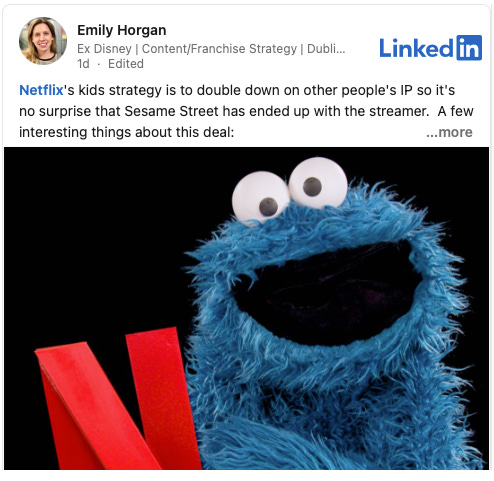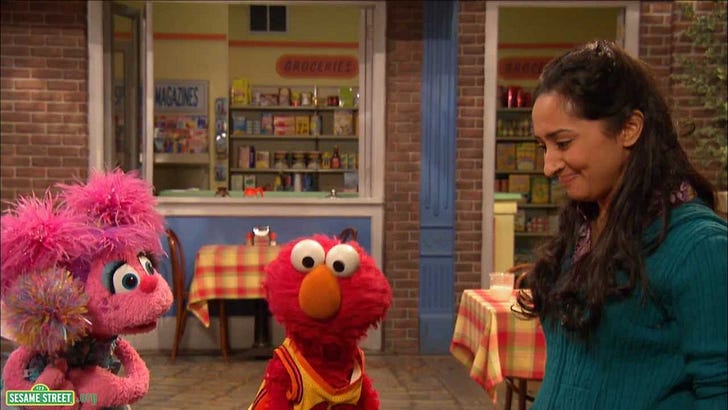The media-sphere was awash this week with news of Sesame Street heading to Netflix. A big deal.
It also came with a sigh of relief. The future of Sesame Workshop’s wholesome, iconic, gorgeous, funny, beloved and thoroughly viable brand had been in question after the streaming service FKA Max dropped the ongoing collaboration just in time for Christmas last year. Ho, ho, NO! The latest slam in a series of decisions that repeatedly smashed the self-destruct button on any sort of kids-targeted strategy for FKA Max. Who needs kids anyway? They’re a niche audience. It’s not like they age and become an inbound stream of customers.
It’s no surprise that Sesame Street ended up at Netflix. These days Netflix’s core kids strategy is to double down on other people’s IP. The announcement was drenched in other major accompanying brands like Peppa Pig, and even Minecraft. I wrote about the headline elements on LinkedIn during the week.

The most interesting element of this deal, dual windowing across platforms, deserved further unpacking. Netflix will play nicely with PBS. Super nicely. Episodes will batch drop on Netflix the same date they commence daily roll out on PBS and the PBS Kids app (on FKA Max there was a nine-month—NINE MONTH!—holdback). This does the right thing by kids, keeping free access to Sesame Street intact for US audiences. We should (and do, right?) all want our youngest audiences to grow up with these types of high-quality, engaging, educational, heartfelt characters and stories. You know that feeling you get when you think about the wonderful TV you grew up with? That. Keeping access to great kids content open for everyone is the right thing to do. Elmo is proud of you for doing that, Netflix, but let’s get real: it’s excellent strategy too.
One of the major problems in streaming as a whole, but particularly with kids, is content discovery. Streaming algorithms carry an air of disposability for series and movies once they age past 28 days. Discovery is streets behind YouTube and TikTok who can successfully niche-ify content and understand that you might need to be served something a few times before you bite. I can go on about this until the cows come home, but that’s a whole other newsletter.
Preschoolers don’t play by the first-28-day rule, of course. They binge content, but care not for the schedule of a media exec. Sampling is also key, which is why Sesame Street’s routine-driven home on PBS is a clear way into the brand. The other thing about preschoolers is that there are new ones all the time, and PBS would be seen as the safest first media touchpoint for many parents. So like I said, it’s strategy… and that’s not a dirty word.
I’ve referred to the Sesame-Netflix relationship so far as a “deal,” but in actuality it’s much more than that. It’s a commitment, a duty, a responsibility. Stewardship of one of the most beloved IPs in America. That makes it a high-profile swing by Netflix, one they’d rather not fumble. They need to make this work, and coming straight out the gate with big, bold strategies is the way to go. And if that doesn’t work, strategize again. Find a way to make it stick. Sesame Street can’t go disposably by the wayside, a fate that has befallen too many Netflix kids shows before. Neither audience, nor industry, nor conscience can let that happen.
Coming Soon
Amid all this, an elephant sits in the room. YouTube was conspicuously absent from the description of this partnership. YouTube is the biggest streaming platform for preschoolers in the world, the front page of their collective digital footprint. But YouTube has historically sit quite uncomfortably with Public Service Broadcasters. By nature a PSB's local mandate creates conflict with YouTube's global approach which could put a spanner in the works for other deals of this nature.
More thoughts on this to come in a Part 2 newsletter.
Other Follow Ups
There were lots of great takes on LinkedIn about this subject, plus great reporting from Ryan Faughnder at the LA Times looking at what this says for FKA Max. I also gave additional thoughts to Janko Roettgers in his Lowpass newsletter, looking at this deal plus the wider Netflix kids strategy.




Thank you for your thoughts on this, Emily!
You are right. Strategy is not a bad word!
I did shudder at the sarcastic suggestion of how some streamers could see kids as growing up to become an inbound stream of customers, though.
In any case, I'll be looking forward to reading Part 2 (and all new entries) on your newsletter.
Looking forward to your thoughts on m YT Emily. We know that netflix has, over time, learnt how to leverage YT's enormous reach to drive discovery and sampling of its own shows. The Gabbys Dollhouse partnership which you have written extensively about is case in point. YT is free and almost ubiquitous like public media but doesn't have its safe haven cache. To not bring the platform into the mix will be shortsighted